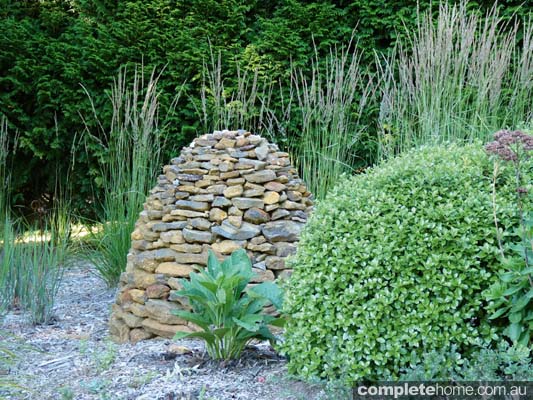Innovative ideas from a fresh green perspective
Cleaning the field
If you have moved into a property where the garden hasn’t been cared for and is a weedy mess, one of the best ways to get this type of ground under control is to grow potatoes. Potatoes are an excellent ground cleaner due to the amount of soil cultivation required before and during the time they’re in the ground, as well as the soil coverage of the potato tops (haulms). This is a wonderful organic method for clearing ground, with the added bonus of a crop at the end of it!
Ready to rock
Rocks offer valuable habitats for a wide variety of insects, lizards and small marsupials. Rocks can be used to make natural-looking garden edging or clumped together as a garden feature, like a rock cairn (as seen in Good Organic Gardening Vol 4 No 1). As well as promoting biodiversity, rocks also work to moderate the immediate climate, radiating stored daytime heat during the night and deflecting breezes.
Save your spiders
A spider can eat up to twice its weight in insects every day, which can be around 2000 insects in an 18-month lifespan. Spiders are arachnids, not insects as commonly thought. They have eight legs and two body segments, whereas insects have six legs and three main body segments. Most are nocturnal unless disturbed and construct webs to feed at night. They are among the most feared organisms but their bad name is largely undeserved as they are true pest-control professionals and play an integral role in controlling insect populations both indoors and outdoors. Consider the benefit to your garden and home of this free pest controller before you brush away cobwebs. Don’t touch spiders, try not to disturb webs and wear boots and gloves when gardening, as some spiders are ground dwellers.
A gardening diary
Keeping a garden diary or detailed journal can prove a very useful tool in the garden. Recording what you’ve planted, when it was planted and the overall result achieved, good or bad, can allow you to evaluate whether it was successful and should be repeated. A spiral notebook is a perfectly practical option — or there’s a range of great gardening journal apps available for smartphones, which allow you to easily input data and take your garden information everywhere you go.
Fruitful gardening
Fallen fruit creates an ideal breeding ground for fungal spores and also attracts pests such as rats, fruit flies, wasps and possums. Ducks and chickens make quick work of leftover fruit and will also aerate the soil around your tree. If you don’t have chickens or other fowl, fruits should consistently be picked up from under the tree and put in the garbage. Don’t compost them or leave them under the tree. To avoid wasted fruit, many fruit varieties allow you to pick them in the early green stages and ripen indoors.
Contending with clay
Clay soils can make it more difficult for garden plants to grow, as deep-rooting plants are often unable to penetrate the spaces between the fine clay particles. Try growing Roly Poly carrots instead of regular carrots; they are round and delicious and don’t need to grow deep in the soil. Gypsum, sand or organic matter can also be mixed with clay to help create a more friable soil structure for successful growing.
Try a new herb
Most garden herbs are usable in the kitchen and there are many with interesting medicinal qualities. Consider adding yarrow, with its pretty white flowers, to your herb patch. A poultice made from yarrow leaves and flowers is known to stop blood flow from nose bleeds or flesh wounds as well as accelerate the healing of cuts and bruises. Yarrow is also one of the best-known herbal remedies for fevers, and a homemade tea infusion will induce sweats that cool fevers and expel toxins. In the kitchen, young leaves can be added to salads or dried to add flavour to cooking.
Can’t beet them
Easy to grow and a delight to eat, beetroot is one of the best vegetables to have in the garden year round. A garden full of beetroot offers fresh and colourful baby leaves that are delicious in salads or the baby beets make a delicious roasted side to any meal. If you can wait until you get a mature tuber, they are ideal for preserving and can be used in sandwiches, burgers and salads.
Seedy solution
After basil flowers, allow the stalks and flowers to dry on the plant. Then run your fingers down the stem to release millions of seeds for next spring’s crop. Place the loose seeds in a tightly closed paper bag or envelope, label and keep in a cool, dry place until planting time.
Edible flowers
Edible flowers make an elegant addition to salads and desserts. Rose petals, jasmine, orange blossom, violas, borage and lavender can lend their delicate flavours to sorbets, custards, jams, jellies, liqueurs, wines and teas. Marigolds, nasturtiums, chrysanthemums and pansies have a duller flavour but offer stunning, splashy colour to salads; they can also be used as garnishes on desserts. The Edible Flower Garden by Rosalind Creasy is worth finding.
Words by Erina Starkey








